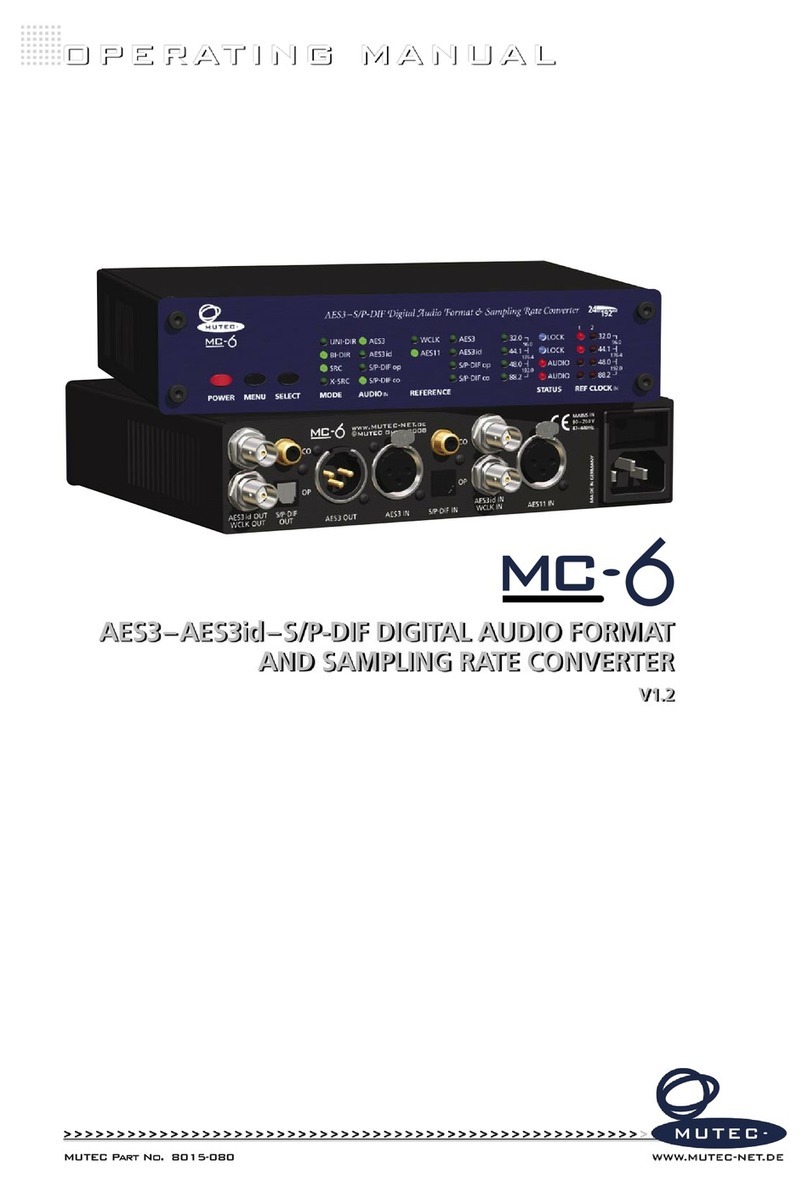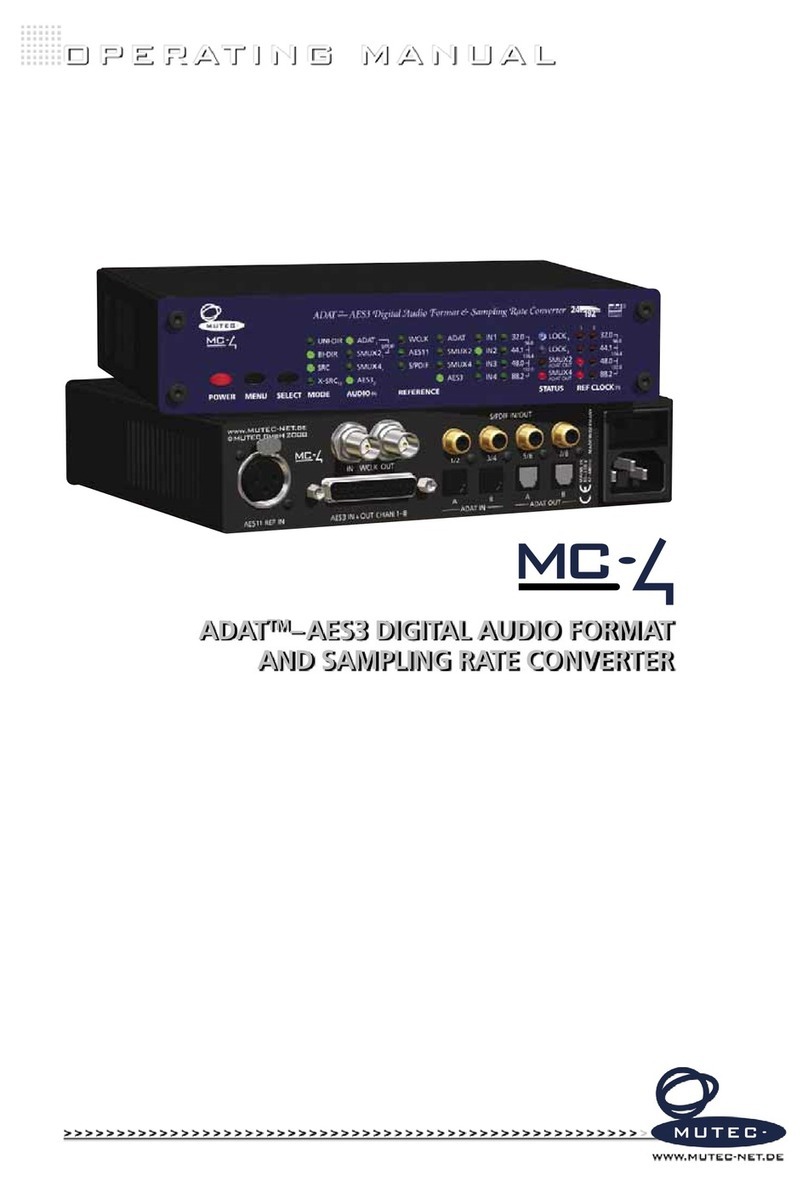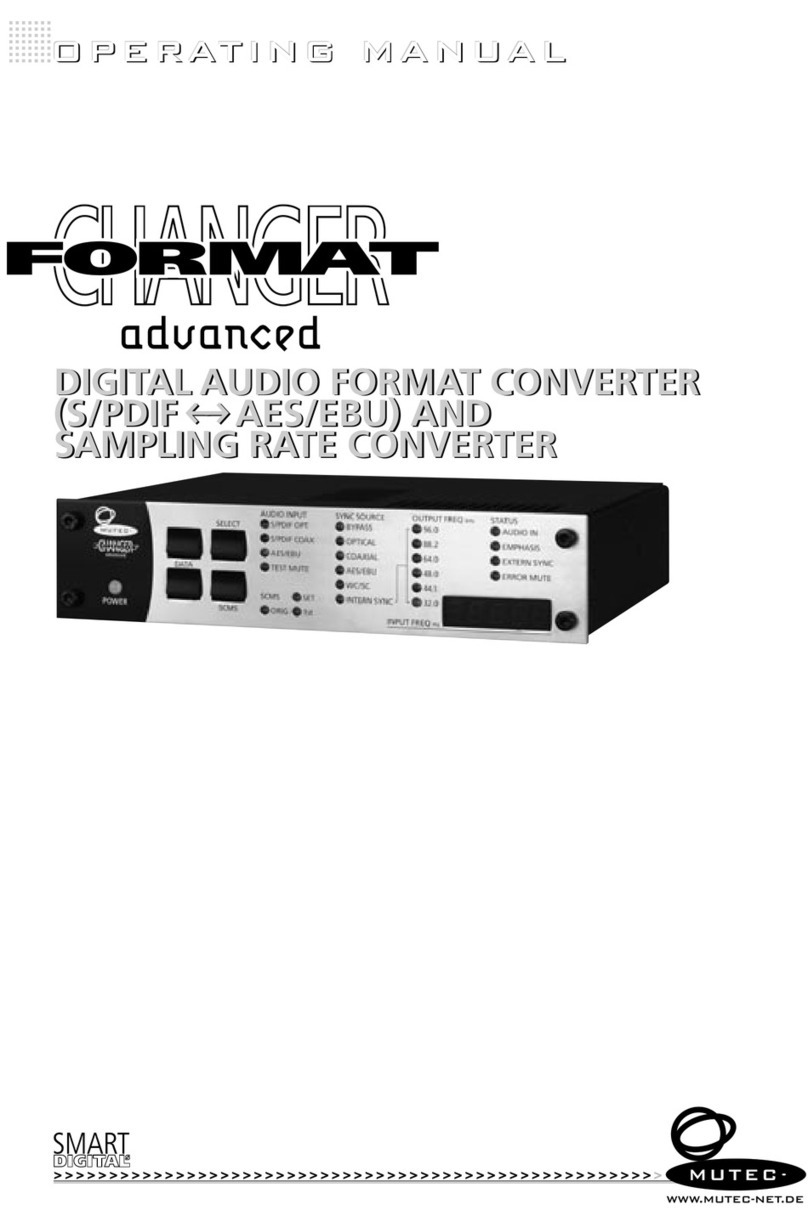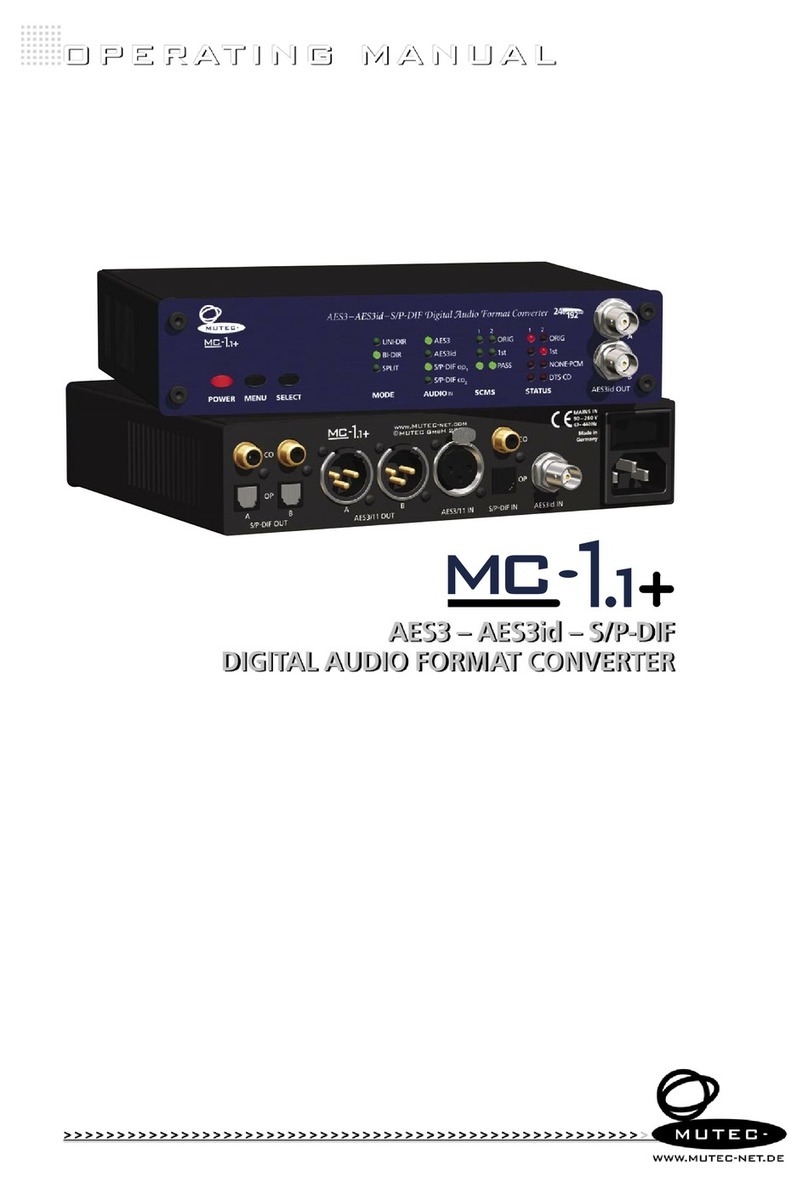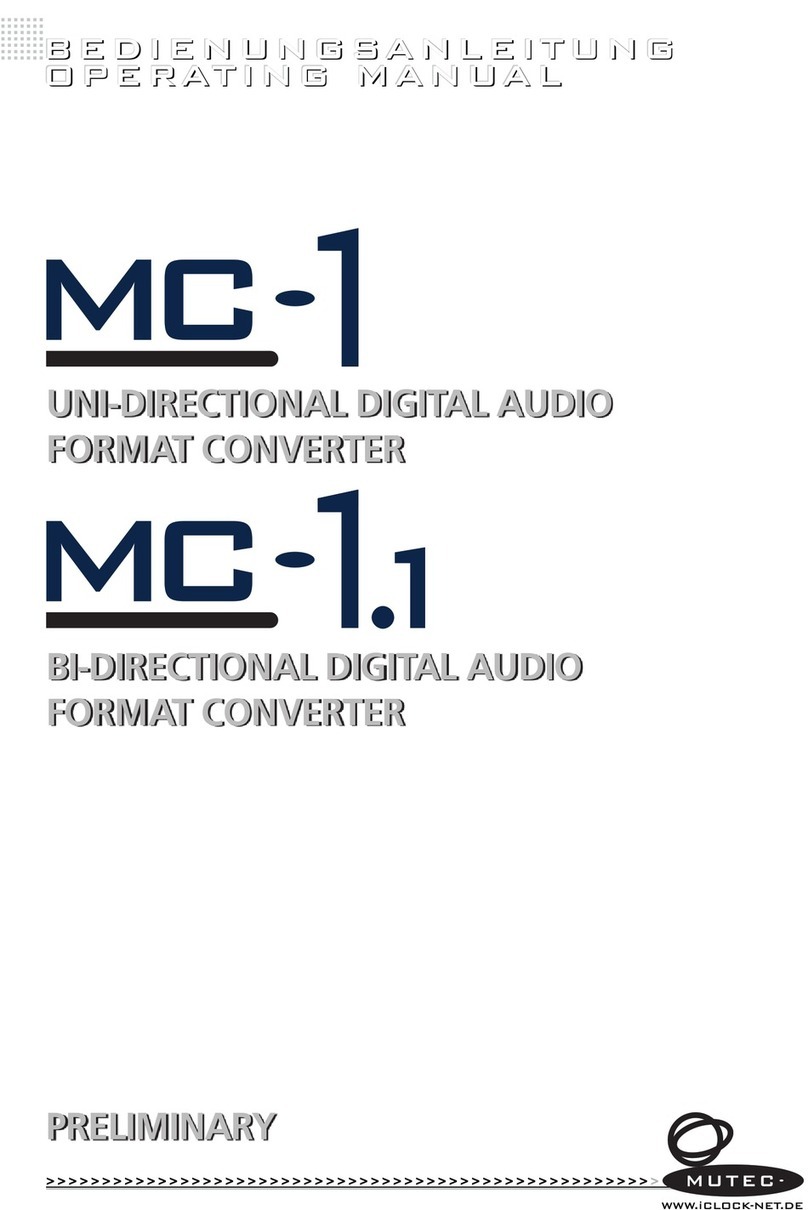MUTEC GmbH assumes no liability for any incorrect information given in this manual. Please note that
all software/hardware product names are registered trademarks of their respective owners. No part of
this manual may be reproduced, copied or converted to a machine-readable form or electronical media
without a written permission of MUTEC GmbH. We reserve the right to change or improve our products
without prior notice. © MUTEC GmbH 2010
WARRANTY REGULATIONS
§1 Warranty
MUTEC GmbH warrants the flawless performance of this product to the original buyer for a period of two (2) years from the date of purchase. If any failure occurs within
the specified warranty period that is caused by defects in material and/or workmanship, MUTEC GmbH shall either repair or replace the product free of charge within 90
days. The purchaser is not entitled to claim an inspection of the device free of charge during the warranty period. If the warranty claim proves to be justified, the product
will be returned freight prepaid by MUTEC GmbH within Germany. Outside Germany, the product will be returned with the additional international freight charges payable
by the customer. Warranty claims other than those indicated above are expressly excluded.
§2 Warranty transferability
This warranty is extended exclusively to the original buyer who bought the product from a MUTEC GmbH specialized dealer or distributor, and is not transferable to anyone
who may subsequently purchase this product. No other person (retail dealer, distributor, etc.) shall be entitled to give any warranty promise on behalf of MUTEC GmbH.
§3 Waranty regulations
The return of the completed registration card, or online registration on one of the websites specified below, is a condition of warranty. Failing to register the device before
returning it for repair will void the extended warranty.
The serial number on the returned device must match the one stated on the registration card or entered during online registration. Otherwise, the device will be
returned to the sender at the sender’s expense.
Any returned device must be accompanied by a detailed error description and a copy of the original sales receipt issued by a MUTEC dealer or distributor.
The device must be returned free of shipping expenses and in the original package, if possible; otherwise, the sender has to provide comparably protective packaging.
The sender is fully responsible for any damage or loss of the product when shipping it to MUTEC GmbH.
§4 Limitation of warranty
Damages caused by the following conditions are not covered by this warranty:
Damages caused by every kind of normal wear and tear (e.g. displays, LEDs, potentiometers, faders, switches, buttons, connecting elements, printed labels, cover
glasses, cover prints, and similar parts).
Functional failure of the product caused by improper installation (please observe CMOS components handling instructions!), neglect or misuse of
the product, e.g. failure to operate the unit in compliance with the instructions given in the user or service manuals.
Damage caused by any form of external mechanical impact or modification.
Damage caused by the user’s failure to connect and operate the unit in compliance with local safety regulations.
Damage caused by force majeure (fire, explosion, flood, lightning, war, vandalism, etc.).
Consequential damages or defects in products from other manufacturers as well as any costs resulting from a loss of production.
Repairs carried out by personnel which is not authorized from MUTEC GmbH will void the warranty. Adaptations and modifications to the device made with regard to
national, technical, or safety regulations in a country or of the customer do not constitute a warranty claim and should be set with MUTEC GmbH in advance.
§5 Repairs
To obtain warranty service, the buyer must call or write to MUTEC GmbH before returning the unit. All inquiries must be accompanied by a description of the problem and
the original buyer’s invoice. Devices shipped to MUTEC GmbH for repair without prior notice will be returned to the sender at the sender’s expense. In case of a functional
failure please contact:
MUTEC Gesellschaft fuer Systementwicklung und Komponentenvertrieb mbH
Si
ekew
e
g 6/
8 • 12
3
0
9 Be
rl
in • G
er
ma
ny • F
on 0
3
0
-746
8
8
0
-
0 • Fax 0
3
0
-74
68
8
0
-9
9 • Tec
sup
p
or
[email protected] • www.MUTEC-net.de
JET and Jitter Elimination Technology are trademarks of TC Applied Technologies Ltd. The JET tech-
nology is used under sublicense from TC Applied Technologies Ltd., and is the intellectual property of
Sonopsis Ltd. Applicable patents include WO2004088845.
SAFETY INSTRUCTIONS
General instructions
To reduce the risk of fire or electrical shock, do not expose this appliance to rain or moisture, direct
sunlight or excessive heat from sources such as radiators or spotlights. No user serviceable parts are in-
side. Repair and maintenance must be carried out by qualified personnel authorized by MUTEC GmbH!
The unit has been designed for operation in a standard domestic environment. Do NOT expose the unit
and its accessories to rain, moisture, direct sunlight or excessive heat produced by such heat sources as
radiators or spotlights! The free flow of air inside and around the unit must always be ensured.
Initial operation
Prior to the initial operation of the unit, the appliance, its accessories and packaging must be
inspected for any signs of physical damage that may have occurred during transit. If the unit has
been damaged mechanically or if liquids have been spilled inside the enclosure, the appliance may
not be connected to the mains or must be disconnected from the mains immediately! If the unit is
damaged, please do NOT return it to MUTEC GmbH, but notify your dealer and the shipping com-
pany immediately, otherwise claims for damage or replacement may not be granted.
If the device is left in a low-temperature environment for a long time and then is moved to a room-
temperature environment, condensation may occur on the inside and the exterior. To avoid short-
circuits and flashovers, be sure to wait one or two hours before putting the device into operation.
Power supply
The device contains a self-adapting wide-range power supply supporting the majority of global stan-
dard line voltages within a range of 90…250 V, with no need for making adjustments. Make sure that
your line-voltage source provides a supply voltage within the specified range. In addition, make sure
that the device is properly grounded via the local electric installation.
Please use the enclosed power cord (see packaging) to connect the unit to the mains. Switch the
unit off before you attempt to connect it to the mains. Connect the power cord to the unit, then
to a standard 3-pin mains outlet. To draw the power cord, never pull on the cable but on the mains
plug!
The unit must be grounded during operation!
For information on the power-inlet wiring, refer to the »Wiring of connectors« section in the
appendix. Disconnect the device from the mains when not using it for an extended period!
This symbol, an exclamation mark inside a triangle,
alerts you to important operating or safety instructions
in this manual.
This symbol, a flash of lightning inside a triangle, alerts
you to the presence of uninsulated dangerous voltage
inside the enclosure - voltage that may be sufficient to
constitute a risk of shock.
Declaration of Conformity
We herewith confirm that the product complies with the European
Commission’s standards on electromagnetic compatibility.
Interference emission: EN 50081-1, 1992
Resistance to interference: EN 50082-1, 1992
Presupposed as operation condition is that all clock outputs are con-
nected with high-quality and good shielded BNC 75 ohms cable.












